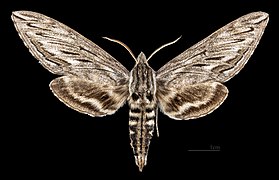
Ceratomia catalpae, the catalpa sphinx, is a hawk moth of the family Sphingidae. The species was first described by Jean Baptiste Boisduval in 1875. Other common names are the Catawba worm, or Catalpa sphinx.

Ceratomia amyntor, the elm sphinx or four-horned sphinx, is a North American moth in the family Sphingidae. The species was first described by Carl Geyer in 1835. It has a wingspan of 3+1⁄4-4+1⁄2 inches. As the name suggests, the larvae (caterpillars) feed on elm trees (Ulmus), but they can also be found feeding on birch (Betula), basswood (Tilia), and cherry (Prunus). When the caterpillars are ready, they crawl to the bottom of the host tree, where they crawl underneath the soil and pupate and may overwinter underground if late enough into the year. Vegetable growers should be aware of this larvae due to its insatiable appetite. One of these larvae are capable in devouring huge amounts of plant's foliage and even succulent stems.

Ceratomia hageni, the Osage orange sphinx or Hagen's sphinx, is a hawk moth. The species was first described by Augustus Radcliffe Grote in 1874.

Ceratomia undulosa, the waved sphinx, is a moth of the family Sphingidae. The species was first described by Francis Walker in 1856. Also known as the "Scorpion Moth".

Paratrea is a monotypic moth genus in the family Sphingidae erected by Augustus Radcliffe Grote in 1903. Its single species, Paratrea plebeja, the plebeian sphinx moth, was first described by Johan Christian Fabricius in 1777. It is found in the eastern part of the United States as far west as Nebraska, Kansas, Oklahoma and eastern Texas.

Sphinx chersis, the great ash sphinx or northern ash sphinx, is a moth that belongs to the family Sphingidae.

Lintneria eremitus, the hermit sphinx, is a moth of the family Sphingidae. The species was first described by Jacob Hübner in 1823. It is found in the temperate areas of the eastern United States, north into southern Canada over the Great Plains. It prefers gardens and yards, but is common wherever the nectar and larval host plants are found. This moth is easily confused with the Canadian sphinx but these two moths do not typically co-occur.
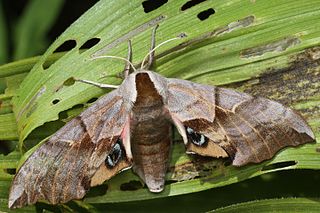
Smerinthus saliceti, the Salicet sphinx, is a moth of the family Sphingidae. The species was first described by Jean Baptiste Boisduval in 1875.

Sphinx franckii, or Franck's sphinx moth is a moth in the family Sphingidae. The species was first described by Berthold Neumoegen in 1893. It is known from lowland deciduous woodland in the eastern United States but also suburban areas where lilacs are planted, ranging from New York to northern Florida east to Missouri and Louisiana.
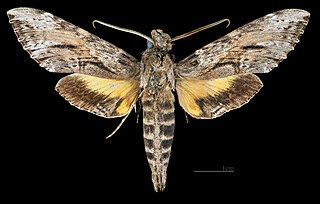
Isognathus rimosa, the rimosus sphinx, is a moth of the family Sphingidae. The species was first described by Augustus Radcliffe Grote in 1865.

Enyo lugubris, the mournful sphinx, is a moth of the family Sphingidae. It is found from Argentina and Paraguay to Uruguay, Venezuela, Guyana, Suriname, French Guiana, Colombia, Ecuador, Peru, Brazil and the West Indies through Belize, Guatemala, Honduras, El Salvador, Nicaragua, Costa Rica and Panama to Mexico and the United States, where it has been recorded from Arizona east to Florida and north to South Carolina. Strays have been recorded from Arkansas, north to Illinois, Michigan and New York.
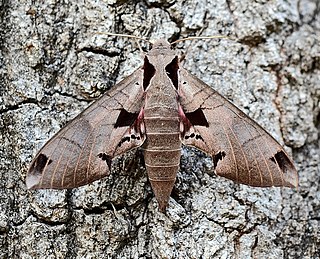
Eumorpha achemon, the Achemon sphinx, is a moth of the family Sphingidae. The species was first described by Dru Drury in 1773.

Hemaris thysbe, the hummingbird clearwing, is a moth of the family Sphingidae (hawkmoths). Coloration varies between individuals, but typically the moth is olive green and burgundy on its back, and white or yellow and burgundy on the underside. Its wings are transparent with a reddish-brown border. It has light-colored legs, which combined with the lack of striping on the underside is diagnostic. Beating its wings rapidly, H. thysbe hovers to collect nectar from a variety of flowers. The combination of its appearance and its behavior commonly leads to it being confused with a hummingbird or bumblebee.

Proserpinus clarkiae, or Clark's sphinx, is a moth of the family Sphingidae. The species was first described by Jean Baptiste Boisduval in 1852. It is known from British Columbia and Washington south through California to Baja California, east to Idaho, Wyoming and Utah. The habitat consists of oak woodland and pine-oak woodland in foothills.
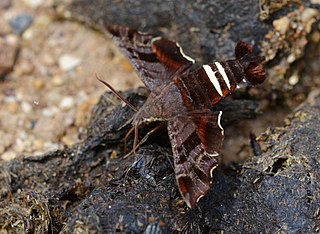
Amphion floridensis, the Nessus sphinx, is a day-flying moth of the family Sphingidae. The species was described by Pieter Cramer in 1777, and renamed in 1920. It is the only member of the genus Amphion erected by Jacob Hübner in 1819. It lives throughout the eastern United States and Canada and occasionally south into Mexico, and is one of the more commonly encountered day-flying moths in the region, easily recognized by the two bright-yellow bands across the abdomen.

Proserpinus lucidus, the Pacific green sphinx or bear sphinx, is a moth of the family Sphingidae first described by Jean Baptiste Boisduval in 1852.

Sphinx kalmiae, the laurel sphinx, is a moth of the family Sphingidae.

Sphinx gordius, the apple sphinx, is a moth of the family Sphingidae. The species was first described by Pieter Cramer in 1780.
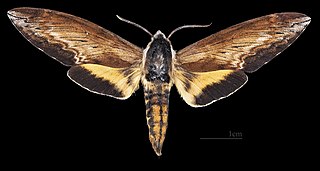
Sphinx luscitiosa, or Clemens' hawkmoth, is a moth of the family Sphingidae. The species was first described by James Brackenridge Clemens in 1859. It is found in North America from Nova Scotia south to New Jersey, west through Michigan, Wisconsin and the northern plains to Alberta, Saskatchewan and Montana and south to Utah. It has been taken as far north as Yukon.
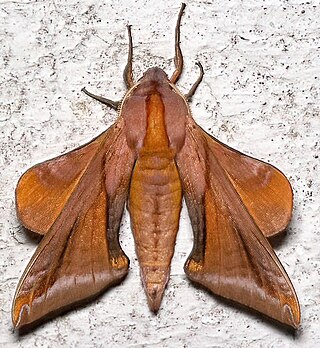
Paonias astylus, the huckleberry sphinx, is a moth in the family Sphingidae. The species was first described by Dru Drury in 1773.

